9 Principles Of Camouflage And Concealment. Plus How To Avoid Mistakes Of Being Seen.
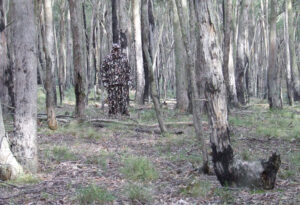
The principles of camouflage and concealment is not just for the military, but also useful for hunting skills. As it teaches awareness that can help for hunting, bowhunting, trapping and acquiring food.
Knowledge on how to use camouflage and concealment, can also help bird watchers and hikers, who want to get a bit closer and observe some wildlife. It can even be useful for fisherman who are trying to sneak up and catch a trout in a small stream.
Don’t just rely on one idea.
Camouflage and concealment doesn’t just mean put on some army camo clothing and you’re done. It is a combination of many camouflage and concealment methods, which different animals have been using to their advantage for millions of years. Both in predator and prey, to avoid being seen.

The 9 principles of camouflage and concealment.
These nine principles all start with an “S”. Some of these techniques may cross into each other. They are: – 1. Shadows, 2. Surface, 3. Shape, 4. Silhouette, 5. Spacing, 6. Shine, 7. Slow and Stationery, 8. Smell, 9. Sound.
Different military organizations might teach six camo principles, or seven “S” and one “M” for movement, etc., but it doesn’t matter, it’s all good if we understand the idea or concept.
- Shadows and light.
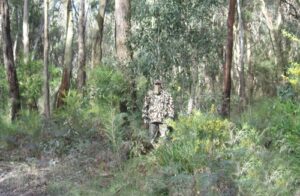
Above picture: Even with effective 3D leaf camo clothing, the bright sun can betray your presence. Use the shadows to your advantage.
Understanding about shadows, is not just about minimizing your shadow, but has three components on how it can help conceal you and be an advantage in the woods.
- Be aware of your shadow in sunlight when moving. Especially when traveling in the morning and late afternoon. As not only the movement of yourself can give you away, but also extra movement of the long shadow.
- When moving in bright daylight, try to stop in shadows from trees or shrubs. This makes it harder for animals (And humans.) to see you, as well as concealing your shape better.
- If you are stopped in a shady spot, you can see things out in the bright daylight better. Try looking at something small a long way away standing in the bright sunshine, then step into the shadows and look at the same object again. You will find that standing in the shadow will improve your vision and reduce glare.
Camo tip. – A wide broad brimmed hat, will shade the side of your face and give more sun protection then a baseball hat. It also helps reduce glare so you can be more effective in seeing items. The shade of the hat can minimizes the shine of your face that animals might see as well.
- Surface. Color, texture and patterns.
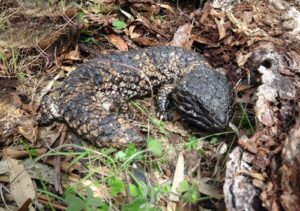 Above image: The Shingleback lizard (Tiliqua rugosa.) uses its natural camouflaged pattern and textured scales to blend in.
Above image: The Shingleback lizard (Tiliqua rugosa.) uses its natural camouflaged pattern and textured scales to blend in.
Making use of textures, colors and patterns that mix in the surroundings can help with camouflage. Likewise a contrasting color, texture and pattern, can stand out.
While a lot of animals are assumed color blind, it is not as simple as they only see in black and white, or grey shades.
As an example deer have different rods and cones in their eyes then humans. (Also be aware of their wide field of vision, and they see well in low light.)
Deer are dichromats and have two color receptors and are believed to see blue, green/yellow wave lengths. (Humans are trichomats and have three color receptors and see red, green and blue.)
Deer can see blues and shades of blue better than humans.
Birds can see even more colors then humans and can easily give away the hunters position by squawking.
Light bright colors and blues should be avoided. Drab colors like dull greens, greys, tans and browns fit into the woodlands nicely.
Big blobs of any one color stand out more, so it is good idea to reduce the size of the blob. Good camo clothing works well by breaking up the human form blob.
You can also break up the human shape by wearing different color pants to the top. As an example, some drab pants and a different color dull plaid shirt. Is it as good as camo clothing? Maybe not, but minimizing movement and scent is more important than camo clothing brand.
Texture of clothing is also important, a shiny silky looking fabric can reflect off light and attract attention. Even camo clothing that is shiny, can make you appear like a beacon to animals.
Some wool and fleece clothing, depending on the material might not reflect light as much and absorb it better, just like an animal hide.
A very flat surface like a tarp or backpack (Not also taking into account it square shape.) can stand out. The surface area can easily be broken up with some natural vegetation in front of it or on it.
On the subject of color, sometimes I think we have our fishing lures designed wrongly. We don’t want the lure to look like a camouflaged fish and be hard to spot. (Just move like a wounded fish and be easier to see.) So instead of a light underbelly and dark top that is hard to see like a real fish. The lure should have a dark underside. (To stand out more for fish looking up.) The top should be a lighter color. (To stand out more for fish looking down.) Of course it will depend on depth, water color, fish species, etc. Sorry, I am rambling on and off subject.
- Shape.
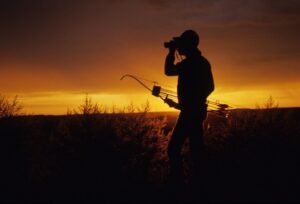
The human outline is distinctive in nature and stands out. Stopping in the open with no cover as in the above image should be avoided. (And cover face up.)
Below picture. A simple tree or foliage behind the person can help break the human shape and outline when stationary.
Items like 3D camo leaf suits and Ghillie suits do a great job at breaking up the human shape and are effective.
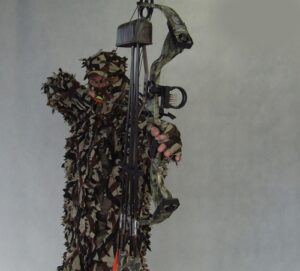
However, a smaller shape will obviously be harder to see then a larger shape. So some 3D Ghillie suits are too big, noisy and bulky. Bits of natural material to break up the head and shoulder outline might be more practical than a whole top and bottom leaf suit, depending on where you are.
Using natural foliage was used long before the commercial Ghillie leaf suits and might be an option.
Boonie hats have branch loops to hold some natural vegetation around the hat.
Another way to conceal the large human shape is to utilize fallen trees and thick bushes for a hunting ground blind. Move some branches to build it up and clear shooting lanes. Ground blinds situated just off active game trails can be effective.
Wind and possible direction of the animals traveling up and down the trail should be considered.
However, as some animals are aware of moved vegetation in their backyard, some hunting blinds are best left for days, or weeks for animals to get used to them.
Similar to a hunting ground blind is a hunting pit blind where it is dug down, instead of building up the cover like the blind.
A pit blind is an effective way to make the human shape appear smaller, as it partially hides you below the ground. A natural depression with foliage around it, can save a lot of digging. (And calories, hydration and noise.)
Besides the work involved, the other negatives of a dug in pit blind is the limited line of sight, as you are lower to the ground. People who have hunted in tree stands understand the big advantage of the field of view it can give being up high.
(For tactical situations a tarp shelter, set lower down to the ground is obviously harder to spot as a smaller shape, then a tarp set up high.)
- Silhouette.
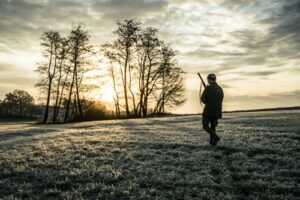
Avoid hunting on top of a hill or a ridgeline, as your form can be silhouetted against the sky.
If you are stalking or stationary, try to have cover in front of you and just as important is too have a tree or bush behind you, (Similar to the shape principle.) to really mask the silhouette of the human form.
As an example the lighter color feathers on the birds underside helps the bird blend in more when viewed underneath. However, the bird can still be silhouetted if there is minimal cover behind it.
If using tree stands for hunting, try to have branches above you, so when animals look up, you are not silhouetted against the sky.
For fishing small rivers and ponds, slowly approach the bank edge (Or it maybe it might be better to crawl up.) cautiously to see if there are any fish actively feeding. Use shadows and avoid silhouetting the body against the sky.
- Spacing.
Spacing of items in nature is generally irregular. Think of a forest with bushes and trees that are growing asymmetrical. Items that are evenly spaced out are normally man made, such as a row of fence posts.
Spacing is more of a concern in the military, (Spacing of soldier’s patrolling.) rather than in a hunting environment, but it is worth mentioning.
On a survival level, if you have to self-rescue, noticing items that are evenly shaped may mean you are getting close to civilization. Such as power-line poles, fence posts and planted rows of tress or crops.
- Shine.
Watches, glasses, jewelry, belt buckles, etc., can glisten in the sun and alert wildlife.
Also something like a silver fox whistle hanging around a hunter neck is shiny and could give away his position. The fox whistle should be tucked down the jacket when not in use.
Your skin can also be shiny and stand out. Cover hands, face and neck up with face veils, bandanas, shemagh, etc.
If clothing can’t cover up exposed skin, camo face paint might be an option.
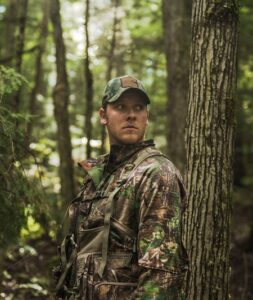
Face paint should be applied on the shiny parts of the face like cheek bones, bridge of nose, ears, exposed neck and back of the hands.
If you haven’t got commercial camo face paint, you can use mud or charcoal. Be warned the charcoal takes a bit to clean it off though.
Buckles on backpacks, shiny new knifes and binocular lenses also can be glary.
Get the brown sharpie, or camo tape out and cover up anything that is shiny.
I have heard of people rubbing their new clothes and day packs in the dirt to reduce the shine.
You can also use glare to your advantage when hunting in the mornings or afternoon. If the wind is in your favor, try to stalk so the rising or setting sun is behind you. As this will make it harder for the game to spot you looking into the strong sun. (The exception is if you are silhouetted against the sky on a hill top.)
- Slow movement and being stationary. (And the effective two step hunting method.)
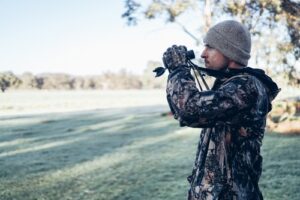
Speed kills. – No I’m not talking about the latest bow that has a blistering IBO speed, I mean speed of movement will kill your chances of seeing game. You can have the best camouflage clothing ever invented, but if you move quickly animals can easily detect you.
A good rule for hunting and bowhunting is to half the speed you are walking now. Then half that speed again. You should be like an old turtle walking with regular stops.
Think of a deer browsing, it feeds, takes a few steps, then eats again. It is slow, pauses often and aware of its surroundings for movement, noise and scent.
The two step method for still hunting. – Another method for slowing down is to take two steps and then stop and scan for wildlife. (Or take four, or six steps, ten steps, etc. It will depend on your terrain and how active the area is for game.)
The two step method does take a lot of patience and practice, however it is a good way of slowing down.
It also works well if you have binoculars, as when you stop, you then systematically glass the area.
After you have taken two steps and looked around (Some people will break up the area to scan into sections. Like close by, long distance, left side, right side, etc.) remember to look back occasionally for wildlife and navigation.
Tip – If you have a weapon such as a bow, gun, atlatl, or rabbit throwing stick, finish the step with your left foot forward. This puts you in a position to be ready for the shot. (Assuming you are right handed.)
I have used the two step technique when still hunting effectively. I even have had deer walk up behind me. (I was lucky with the wind.)
The two step method is also effective for eliminating noises. After you have slowly scanned the area out front for wildlife, look down and see where you are going to walk next and place your feet.
I try and make the direction towards stopping in shadows, into the wind and away from noisy vegetation. Looking down also helps avoiding stepping on noisy sticks. (And snakes.) You can also spot more wild edibles.
The slower your movement is, the more you see and the less sound you will also make!
Not only should your feet be steeping slowly, minimize your movement with your hands and head. Squatting flies and mosquitoes away with your hands can easily scare off animals. So slowly move your hands.
Also turn your head slowly. (Less movement then your whole body turning.)
Even better then moving slowly, is being stationary. You can also see a lot more while being still. Sitting on a log, it is amazing how far away you can see a butterfly, or small bird flying because of their movement.
Being stationary (And minimizing scent.) is the key for seeing more wildlife and more effective than a person moving in head to toe camo clothing.
Tip. – Opposite of limiting movement for camouflage, is to create visual attractors for enticing predatory animals. Bright bird feathers, or hanging strips of rabbit skins (White underside.) hanging from a branch, moving in the wind can help attract animals to baited traps and snares.
- Smell.
From the humble bunny to the elusive deer, smell plays a big part in your hunting success. If possible hunt with the wind in your face to reduce your scent being carried.
As a generality, in the mornings the air starts to warm up and starts to rise carrying your scent up hill. In this case you might be better higher up on hills and mountains for a start. (Deer might be feeding in the lower paddocks overnight. Then in the early morning start heading up hill to the bedding areas. This works in well for the hunter higher up on the hill for an ambush.)
In the evenings the cold air descends, bringing the scent down, so hunting in the gullies and valleys might be an option. (Deer might start coming down the hill from their bedding areas in the evenings to start feeding in the paddocks below. This again works in well for the hunter lower in the gully with the scent being minimized.)
As well as taking the wind into account and your scent, try to avoid strong smelling foods. While hot curries, coffee, garlic are nice, be careful what you eat, drink and handle before trapping or hunting.
It also goes without saying to avoid smoking and getting other strong smells like gasoline (Petrol.) on your clothing.
If you do sweat a lot, try scent free deodorants and slow your movement right down so you don’t get hot.
Some hunters will rub in strong smelling foliage that is in the area on their clothes. Others have been known to even deliberately step in ungulate scat (Poop from hooved animals.) to try and minimize the human smell.
For setting traps and snares, I have heard of trappers rubbing cold ashes and charcoal from the fire on their hands before setting the traps, to help disguise their scent.
While you can never completely eliminate your scent, some methods might just increase your chances a little bit. It is open for debate just how much human scent control works, but it might be enough to help put food on the table though.
On the flip side of minimizing your smell, you can use scent like apples, berries, native fruits and tubers to try and attract animals for trapping.
For predatory animals the smell of left over game intestines and fish guts, etc., can help attract them. (Remember to look though the fish intestines to see what they are eating as well, this bait might be re-used. This also helps you know what the fish have been eating.)
Tip. – I tie a fine bit of cotton on my longbow tip, this helps indicate which way the wind is going. If the wind is light, you can use thistle seed heads or cattail fluff, to see which way the wind is going. (Dry seed heads can also be mixed in for fire lighting tinder bundles.)
Practicing the skills of moving slowly and taking into account your scent is hard work, but can be fun. It also helps your observation skills for tracking and more awareness of nature.
- Sound.
If you do make a big noise when stalking, don’t give up. Just stay still as long as possible, as sound in the woodlands is quiet common. Such as the rustling of leaves when the wind is blowing, or falling tree limbs.
A lot of animals will just freeze and try to see what the noise was. They may not run off when they hear sound, but they will if they see movement, or hear more continued unnatural sounds.
A person ploughing through the woods at full speed and stamping their feet noisily is not a natural sound in the woods. (I swear my children are part elephant when hunting.)
Walking quietly. – When still hunting, slowly place your ball of your foot in front of you. Test the ground to make sure you are not placing your foot on sticks, noisy leaves, etc. If the ground is firm and quiet, finish slowly transferring the weight of the whole foot on the ground. Repeat the process with the other foot.
Remember the two step hunting method to slow you down and also look on the ground to avoid noisy vegetation.
Wet and drizzly days help dampen the forest floor vegetation and make hunting a lot quieter.
Moccasins and soft soled shoes make walking quieter.
I have heard of hunters and bow hunters placing large socks over their boots when stalking game to minimize the noise of the hard sole.
Taking your boots completely off for stalking in bare feet to minimize sound in dry leaves is another option.
I guess you would have to weigh up the possibilities of prickles, snakes, etc., on the ground, against the advantages of making less noise with bare feet. I have tried it a few times when bowhunting, it definitely slows you down though. But I think I was more worried about stepping on bull ants, rather than purely concentrating on hunting.
Survival instructor Cody Lundin author of, “98.6 Degrees, The Art Of Keeping Your Ass Alive.” suggests bare feet has a lot of advantages. (By the way, it is a good survival book to read.)
If the woods are very dry underfoot, one of the best ways to minimize noise is to be stationary. Sitting just off an active game trail and glassing with the wind in your face will increase your chances for success. Practice being patient is a good skill to learn when young.
Don’t forget to turn your mobile phones to silent mode.
One embarrassing story happened to me early one morning when hunting. I was walking along a track to an active deer hot spot, when my mobile phone alarm went off. I tried to quickly turn it off, but it just got louder with each ring. I fumbled about deep in my pockets, but my gloves made it hard to turn it off. Eventually I switched it off. I wonder why I didn’t see any deer that morning!
The sounds of birds squawking (Or no sounds.) might also be an indicator that there is a predator around, such as a fox, etc.
Tip to minimize noise. – When you are kitted up with your backpack or hunting gear on, try jumping up and down on the spot. You might hear your keys rattling in your pocket, or sloshing of your half empty canteen, or mess kit banging. Tighten, fix and tape any noisy equipment before you head into the woods.
Camo for search and rescue?
Understanding the techniques of camouflage not only helps in your hunting and bowhunting craft, but can also be used in a wilderness rescue situation. In this case, you can just think the opposite of these principles. As an example, a shiny surface can scare off animals, but can attract the attention of a search and rescue team in an emergency situation.
An example of doing the opposite for camouflage techniques for search and rescue is to use a bright contrasting color such as an orange bandana or a bright dry bag waived high about, creating movement.
Conclusion – 9 Principles of camouflage and concealment.
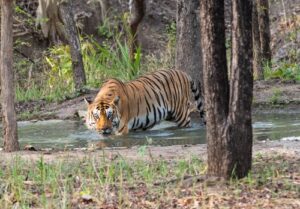
Camo and concealment knowledge is an important skill for hunting and also useful for field-craft and survival.
Remember to use a combination of these ideas and not just rely on one technique.
Think of a tiger, who has a striped coat that can help break up her shape with the partial shade and sunlight of the jungle. However, she doesn’t just rely solely on her camouflage pelt. The tiger will use vegetation to move in and behind. She will slowly, deliberately and quietly sneak up on animals, or ambush its prey.
A tiger will use most camouflage and concealment principles of sound, smell, slow or stationary movement, shadows, etc., to her advantage.
Thank you for your time reading this article and I hope you enjoyed principles of camouflage and concealment.
